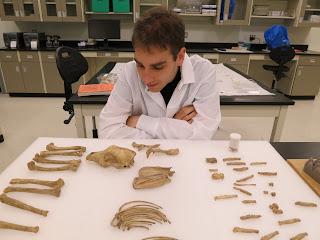Our latest Sustainable Archaeology: McMaster guest post is by research volunteer Chris Kendall, a fourth year Honours Anthropology student at McMaster University.
Ancient DNA and Its Applications to Ontario Archaeology
By: Chris Kendall, Honours Anthropology (IV), McMaster University
My role as a research volunteer at Sustainable Archaeology: McMaster, attempts to marry the molecular biological side of anthropology with its archaeological foundations. Over the course of the past semester, I have been examining the collections, working with staff and volunteers, and preparing a technical bulletin for the application of ancient DNA (aDNA) analysis in Ontario. While I was preparing this bulletin, I kept in mind the materials available in the collections, as well as some information researchers may need when beginning a project on aDNA analysis of Ontario archaeological finds. The technical bulletin outlines methodological frameworks on how to select ideal samples for aDNA analysis within the curated samples housed at the Sustainable Archaeology. From a genetics standpoint, many of the samples hold great potential for study. An abundance of faunal remains, combined with agricultural and botanical remains, hair, and sediment may be analyzed for aDNA material.
The technical bulletin suggests proper storage techniques for organic samples in order to optimally preserve the genetic material. For example, fibres recovered from a water-logged site should be kept in ultra-pure water and not tap water since the chlorine can destroy any remaining DNA. This document can serve as a reference guide to both external researchers interested in using the collections, but also for the facility’s staff to ensure minimal damage and contamination occur to these specimens. It is hoped that from this technical bulletin more researchers will apply aDNA analysis to the study of the faunal and agricultural remains of Ontario.
Of particular interest to me, is trying to better understand the evolutionary relationships of Ontario archaeological dog specimens. There are many dog skeletons currently in the collection, however, no phylogenetic relationships have been established for these groups, while other North American dog samples have been widely studied (Barta, 2007; Brown et al., 2012, for example). One study by Bathurst and Barta (2004) examined a dog with tuberculosis found at an Ontario Iroquois site, which is currently stored at Sustainable Archaeology: McMaster. Bathurst and Barta (2004) made inferences about human-canine interactions of these people based upon the genetic and skeletal markers, as well as the burial context of the animal. Further analysis of similar remains could look at domestication and migration patterns, which has rarely been studied in the context of Ontario archaeology sites.

My time spent at the lab has been extremely beneficial. The collections are vast and exciting, so the ability to work so closely with them was a great opportunity. Working with the lab group has taught me a wide variety of skills I have found to be quite complementary to my academic life as both an undergraduate and hopeful graduate student. For instance, I learned that many other sources of DNA exist apart from tissue and skeletal remains. I also became aware of several rules of thumb for storing specimens I was not aware of before researching for this bulletin, such as storing items in humid conditions can lead to hydrolytic damage of the DNA. I also learned that differing techniques for isolating and extracting DNA can give varying results, as can cross-sectioning versus powdering a tooth or using cancellous instead of spongy bone.
Perhaps the most rewarding experience of all is being in contact with individuals with such a wide variety of research interests and schools of discipline. It is interesting to work with researchers, fellow undergraduates, and graduate students all dedicated to better understanding the past human experience of living in Ontario. In doing this, archaeologists work closely with ceramic experts, who collaborate with historians, museums, bioarchaeologists, and others. This blending of mutual interest creates a dynamic work and research environment that I am extremely grateful to be involved with.
References:
Barta, Jodi Lynn
2007 Addressing Issues of Domestication and Cultural Continuity on the Northwest Coast Using Ancient DNA and Dogs. PhD Dissertation, Department of Anthropology, McMaster University.
Bathurst, Rhonda R. and Jodi Lynn Barta
2004 Molecular Evidence of Tuberculosis Induced Hypertrophic Osteopathy in a 16th Century Iroquoian Dog. Journal of Archaeological Science, 31: 917-925, doi:10.1016.j.jas.2003.12.006
Brown, Sarah K., Christyann M. Darwent, and Benjamin N. Sacks
2012 Ancient DNA Evidence for Genetic Continuity in Arctic Dogs. Journal of Archaeological Science xxx 1-10, doi: http://dx.doi.org/10.1016/j.jas.2012.09.010